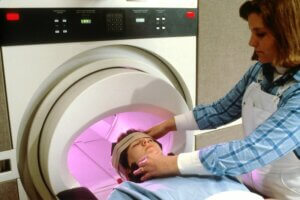
Bladder cancer is one of the ten most common cancers in the UK (Photo credit: National Cancer Institute)
Bladder cancer: a brief guide
Every year over 21,500 people are diagnosed with bladder cancer (58 people every day) making it one of the ten most common cancers in the UK.
In the UK bladder cancer accounts for 4.5% of all new cancer cases and over 100,000 people are living with this form of cancer.
Bladder cancer has a high mortality rate of around 50% and diagnosis can often be late. Approximately 25% of all cases are diagnosed at a late stage, particularly in women.
Patient outcomes can be considerably improved by early diagnosis – up to 80% survival rate if caught early enough – so we want to raise awareness both among the public and GPs of the symptoms and the need to take action much earlier.
Bladder cancer affects all ages, both men and women, with almost three quarters of cases occurring in men and has the highest recurrence rate of any known cancer – up to 80%.
Recognising the signs and symptoms of bladder cancer
Bladder cancer is a growth of abnormal tissue (called a tumour), which forms in the lining of the bladder. For some people, the tumour may grow further into the other layers of the bladder. As the cancer grows into the other layers in the bladder, it becomes more advanced and harder to treat.
Bladder cancers are classified based on how far they have invaded into the wall of the bladder:
- Non-muscle invasive bladder cancers are still in the inner layer of cells (the transitional epithelium) and the thin middle layer (the lamina propria) but have not grown into the deeper layers.
- Muscle invasive bladder cancers grow beyond the epithelium into the deeper layers of muscle. These types of tumours are more difficult to treat and are more likely to spread.
The most common symptom of bladder cancer is blood in your urine. You may notice streaks of blood in your urine or the blood may turn your urine brown. The blood isn’t always noticeable and it may come and go.
Less common symptoms of bladder cancer include:
- a need to urinate on a more frequent basis
- sudden urges to urinate
- a burning sensation when passing urine
If bladder cancer reaches an advanced stage and has spread, symptoms can include:
- pelvic pain
- bone pain
- unintentional weight loss
- swelling of the legs
If you have blood in your urine – even if it comes and goes – you should visit your GP, so the cause can be investigated.
Understanding the risk factors for bladder cancer
Bladder cancer is caused by changes to the cells of the bladder. It’s often linked with exposure to certain chemicals, but the cause isn’t always known.
Factors that can significantly increase your risk of developing bladder cancer include:
- Smoking is the single biggest risk factor for bladder cancer. This is because tobacco contains cancer-causing (carcinogenic) chemicals. It’s estimated that more than a third of all cases of bladder cancer are caused by smoking. People who smoke may be up to four times more likely to develop bladder cancer than non-smokers.
- Exposure to certain industrial chemicals is the second biggest risk factor. Previous studies have estimated that this may account for around 25% of cases.
Some non-manufacturing jobs have also been linked to an increased risk of bladder cancer. These include taxi or bus drivers, as a result of their regular exposure to the chemicals present in diesel fumes.
Other factors that can increase your risk of bladder cancer include:
- radiotherapy to treat previous cancers near the bladder, such as bowel cancer
- previous treatment with certain chemotherapy medications
- having certain treatments for type 2 diabetes
- having a tube in your bladder (an indwelling catheter) for a long time, because you have nerve damage that has resulted in paralysis
- long-term or repeated urinary tract infections (UTIs)
- long-term bladder stones
- an untreated infection called schistosomiasis (bilharzia), which is caused by a parasite that lives in fresh water – this is very rare in the UK
How bladder cancer spreads
Bladder cancer usually begins in the cells of the bladder lining. In some cases, it may spread into surrounding bladder muscle. If the cancer penetrates this muscle, it can spread to other parts of the body, usually through the lymphatic system.
If bladder cancer spreads to other parts of the body, such as other organs, it’s known as metastatic bladder cancer.

Tests for bladder cancer can include having an MRI scan (photo credit: National Cancer Institute)
Bladder cancer diagnosis
If you have symptoms of bladder cancer, such as blood in your urine, you should see a GP.
Your GP may ask about your symptoms, family history and whether you’ve been exposed to any possible causes of bladder cancer, such as smoking.
In some cases, your GP may request a urine sample, so it can be tested in a laboratory for traces of blood, bacteria or abnormal cells.
Your GP may also carry out a physical examination of your rectum and vagina, as bladder cancer sometimes causes a noticeable lump that presses against them.
If your doctor suspects bladder cancer, you’ll be referred to a hospital for further tests, which could include:
- A cystoscopy
- A CT scan or an MRI scan
- An intravenous (IV) urogram
Exploring the treatment options for bladder cancer
If abnormalities are found in your bladder during a cystoscopy, you should be offered an operation known as TURBT (Transurethral resection of a bladder tumour). This is so any abnormal areas of tissue can be removed and tested for cancer (a biopsy).
Sometimes, a sample of the muscle wall of your bladder is also taken to check whether the cancer has spread. This may be a separate operation within six weeks of the first biopsy.
You should also be offered a dose of chemotherapy after the operation. This may help to prevent the bladder cancer returning, if the removed cells are found to be cancerous.
Treatments usually differ between early stage, non-muscle-invasive bladder cancer and more advanced muscle-invasive bladder cancer.
- If you’ve been diagnosed with non-muscle-invasive bladder cancer (stages CIS, Ta and T1), your recommended treatment plan depends on the risk of the cancer returning or spreading beyond the lining of your bladder.
- Low-risk non-muscle-invasive bladder cancer is treated with transurethral resection of a bladder tumour (TURBT). This procedure may be performed during your first cystoscopy, when tissue samples are taken for testing (see diagnosing bladder cancer).
- TURBT is carried out under general anaesthetic. The surgeon uses an instrument called a cystoscope to locate the visible tumours and cut them away from the lining of the bladder. The wounds are sealed (cauterised) using a mild electric current, and you may be given a urinary catheter to drain any blood or debris from your bladder over the next few days.
After surgery, you should be given a single dose of chemotherapy, directly into your bladder, using a catheter.
While you are here, why not check your emotional wellbeing with our Cancer Compass checker. In just a few seconds discover the practical and emotional support we provide. Click here to find out which area of support might be right for you or someone you know.
Most people can leave hospital less than 48 hours after having TURBT and are able to carry out normal physical activity within two weeks.
People with intermediate-risk non-muscle-invasive bladder cancer should be offered a course of at least six doses of chemotherapy.
If you have high-risk non-muscle-invasive bladder cancer, you should be offered a second TURBT operation, within six weeks of the initial investigation (see diagnosing bladder cancer). A CT scan or an MRI scan may also be needed.
Your urologist and clinical nurse specialist will discuss your treatment options with you, which will either be:
- a course of Bacillus Calmette-Guérin (BCG) treatment – using a variant of the BCG vaccine
- an operation to remove your bladder (cystectomy)
Navigating the path to recovery after bladder cancer treatment
Depending on which stage of bladder cancer you have been diagnosed with, you should be offered follow-up appointments using a cystoscopy:
- Low risk early bladder cancer – three and nine months to check your bladder.
- Intermediate (moderate) risk early bladder cancer – three, nine and 18 months, then once every year.
- High-risk non-muscle-invasive bladder cancer – every three months for the first two years, then every six months for the next two years, then once a year.
Returning to everyday life after bladder cancer
Regaining a sense of normality after bladder cancer treatment involves adjusting to lifestyle changes and finding new routines.
You may find that friends and family expect you to return to your old self quickly, but people who have had bladder cancer tell us it isn’t that easy.
It helps if you:
- Remember to pace yourself. Gradually reintroduce activities and responsibilities, allowing your body and mind time to adjust
- Prioritise self-care. Incorporate regular exercise, healthy eating habits, and adequate sleep to promote overall wellbeing
- Seek supportive resources. Utilise community resources, support groups, and online platforms to connect with others who share similar experiences. Your doctor or specialist nurse should know who you can contact to get help. They can put you in touch with professionals who are specially trained in supporting people with cancer. These people are there to help you so use them if you feel you need to.
- Try to embrace new perspectives. Re-evaluate your priorities and passions, exploring new hobbies, interests, or volunteer opportunities
- Ask for help if you need it. Remember, the path to recovery is a journey, not a race. Embrace each step with patience, self-compassion, and the support of those around you. You are not alone in this journey, and there are numerous resources available to help and guide you along the way.
Emotions
- Acknowledging emotions. You may experience a number of emotions after a bladder cancer diagnosis. Treatment can also cause changes in your body, which can affect how you feel in yourself. It is important to remember that everyone reacts differently and that feelings are a natural way of coming to terms with cancer. You may feel some or all of the following feelings:
- Numb
- frightened and uncertain
- confused
- angry and resentful
- guilty
- anxious/worried
- Seeking support. Connecting with support groups like Cancer Coach, therapists, or trusted individuals to share your experiences and receive emotional support
- Making body image adjustments. Embrace changes in your body with self-compassion and explore ways to enhance your self-esteem
- Mindfulness practices. Engage in mindfulness techniques such as meditation, yoga, or journaling to manage stress and promote emotional well-being.



